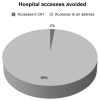Active home-based cancer treatment
- PMID: 22807631
- PMCID: PMC3396069
- DOI: 10.2147/JMDH.S31494
Active home-based cancer treatment
Abstract
Background: Active home-based treatment represents a new model of health care. Chronic treatment requires continuous access to facilities that provide cancer care, with considerable effort, particularly economic, on the part of patients and caregivers. Oral chemotherapy could be limited as a consequence of poor compliance and adherence, especially by elderly patients.
Methods: We selected 30 cancer patients referred to our department and treated with oral therapy (capecitabine, vinorelbine, imatinib, sunitinib, sorafenib, temozolomide, ibandronate). This pilot study of oral therapy in the patient's home was undertaken by a doctor and two nurses with experience in clinical oncology. The instruments used were clinical diaries recording home visits, hospital visits, need for caregiver support, and a questionnaire specially developed by the European Organization for Research and Treatment of Cancer (EORTC), known as the QLQ-C30 version 2.0, concerning the acceptability of oral treatment from the patient's perspective.
Results: This program decreased the need to access cancer facilities by 98.1%, promoted better quality of life for patients, as reflected in increased EORTC QLQ-C30 scores over time, allowing for greater adherence to oral treatment as a result of control of drug administration outside the hospital. This model has allowed treatment of patients with difficult access to care (elderly, disabled or otherwise needed caregivers) that in the project represent the majority (78% of these).
Conclusions: This model of active home care improves quality of life and adherence with oral therapy, reduces the need to visit the hospital, and consequently decreases the number of lost hours of work on the part of carers. Management of the service by the professionals involved revealed excellent control of the process by nursing staff, with minimal visits involving doctors.
Keywords: cancer; compliance; home-based; quality of life; treatment.
Figures
Similar articles
-
Effect of a structured, active, home-based cancer-treatment program for the management of patients on oral chemotherapy.Patient Prefer Adherence. 2014 Jun 25;8:917-23. doi: 10.2147/PPA.S62666. eCollection 2014. Patient Prefer Adherence. 2014. PMID: 25028540 Free PMC article.
-
Health-related quality of life in early breast cancer.Dan Med Bull. 2010 Sep;57(9):B4184. Dan Med Bull. 2010. PMID: 20816024
-
Comparison of two quality-of-life instruments for cancer patients: the functional assessment of cancer therapy-general and the European Organization for Research and Treatment of Cancer Quality of Life Questionnaire-C30.J Clin Oncol. 1999 Sep;17(9):2932-40. doi: 10.1200/JCO.1999.17.9.2932. J Clin Oncol. 1999. PMID: 10561373
-
Assessment of change of quality of life in terminally ill patients under cancer pain management using the EORTC Core Quality of Life Questionnaire (QLQ-C30) in a Korean sample.Oncology. 2008;74 Suppl 1:7-12. doi: 10.1159/000143212. Epub 2008 Aug 28. Oncology. 2008. PMID: 18758191
-
Psychometric validation of the Moroccan version of the EORTC QLQ-C30 in colorectal Cancer patients: cross-sectional study and systematic literature review.BMC Cancer. 2021 Jan 27;21(1):99. doi: 10.1186/s12885-021-07793-w. BMC Cancer. 2021. PMID: 33499819 Free PMC article.
Cited by
-
Homcology: home chemotherapy delivery in a simultaneous care project for frail advanced cancer patients.Support Care Cancer. 2021 Feb;29(2):917-923. doi: 10.1007/s00520-020-05569-9. Epub 2020 Jun 13. Support Care Cancer. 2021. PMID: 32533437
-
Domains of Structured Oral Anticancer Medication Programs: A Scoping Review.Oncol Nurs Forum. 2022 Jun 17;49(4):296-306. doi: 10.1188/22.ONF.296-306. Oncol Nurs Forum. 2022. PMID: 35788732 Free PMC article.
-
"It's a part of the patient": The experiences of patients with cancer undergoing home-based chemotherapy from patients' and nurses' perspectives.Asia Pac J Oncol Nurs. 2022 Apr 22;9(8):100072. doi: 10.1016/j.apjon.2022.04.011. eCollection 2022 Aug. Asia Pac J Oncol Nurs. 2022. PMID: 35692730 Free PMC article.
-
Importance of adherence to BCR-ABL tyrosine-kinase inhibitors in the treatment of chronic myeloid leukemia.Rev Bras Hematol Hemoter. 2014;36(1):54-9. doi: 10.5581/1516-8484.20140014. Rev Bras Hematol Hemoter. 2014. PMID: 24624037 Free PMC article. Review.
-
The cost of molecular-guided therapy in oncology: a prospective cost study alongside the MOSCATO trial.Genet Med. 2017 Jun;19(6):683-690. doi: 10.1038/gim.2016.174. Epub 2016 Dec 1. Genet Med. 2017. PMID: 27906201
References
-
- Palmieri FM, Barton DL. Challenges of oral medications in patients with advanced breast cancer. Semin Oncol Nurs. 2007;23(4 Suppl 2):17–22. - PubMed
-
- Liu G, Franssen E, Fitch MI, et al. Patient preferences for oral versus intravenous palliative chemotherapy. J Clin Oncol. 1997;15:110–115. - PubMed
-
- Demetri GD, von Mehren M, Blanke CD, et al. Efficacy and safety of imatinib mesylate in advanced gastrointestinal stromal tumors. N Engl J Med. 2002;347:472–480. - PubMed
-
- Welt A, von Minckwitz G, Oberhoff C, et al. Phase I/II study of capecitabine and vinorelbine in pretreated patients with metastatic breast cancer. Ann Oncol. 2005;16:64–69. - PubMed
LinkOut - more resources
Full Text Sources



